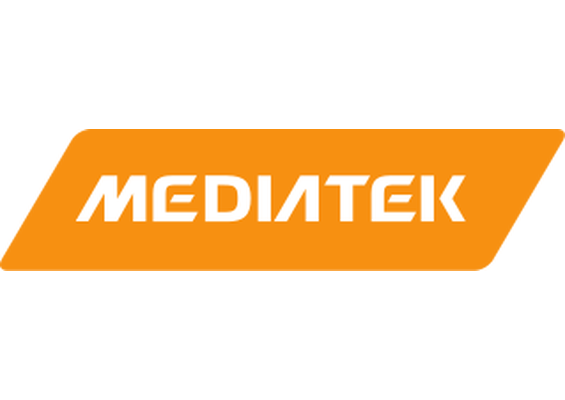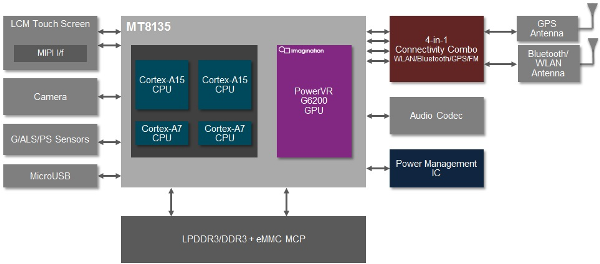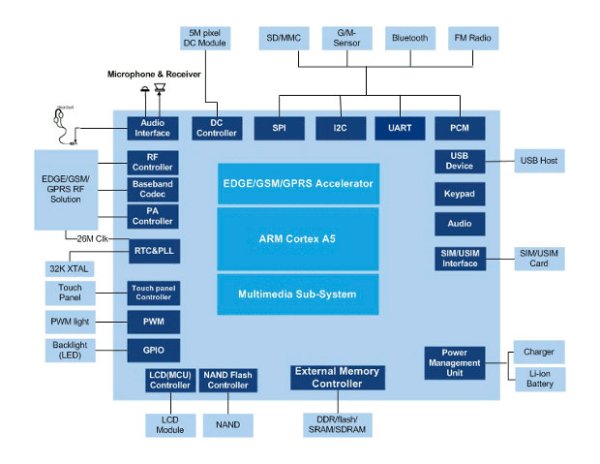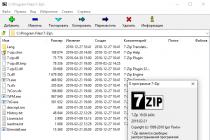Review of Chinese SoC Platforms with ARM License | Chinese chips are ready to conquer the world
Rockchip, Allwinner, Spreadtrum and MediaTek are brands that most users may not be familiar with, but all of these companies compete with Samsung, Qualcomm, and Nvidia for market share in Android devices.
When it comes to Android, products like Google's Nexus are often mentioned. Galaxy series from Samsung or Asus Transformer, along with HTC, LG and Sony devices. And sometimes, depending on the success of marketing campaigns and word of mouth, the names of SoC platforms that are used in these smartphones and tablets become known: Exynos, Snapdragon, Tegra. More and more companies are competing for your money by expanding their product range, and Chinese SoC platform manufacturers are constantly making their way into the low-cost Android market. Android, iOS and other mobile platforms are heavily dependent on the British company ARM Holdings. Its history takes us back to the first commercially successful 8-bit home PC, created in the early 1980s and called the BBC Micro. It was one of three computers which set the motion for the UK and European home PC markets. The BBC Micro rivalry, along with another 8-bit system, the Sinclair ZX Spectrum, has already made history and is legendary.
After the resounding success of BBC Micro, the PC company Acorn took its first steps towards optimizing 16-bit processors. By cleverly simplifying and removing frequently repeated instructions, Acorn developed a more powerful device that could show better performance at a lower cost. This approach is called RISC, which means "reduced instruction set computer". First this technology appeared in 1983 in the 16-bit Acorn RISC Machine, or ARM for short, one of the first real working multitasking operating systems (RISC OS), which, incidentally, was recently reissued as open source for the popular Raspberry Pi PC - another ARM-based devices.
With a focus on performance, the company has built its own range of RISC PCs and operating systems for the next decade. ARM Holdings later moved on to platform development entry level for all types of devices, from simple disk controllers to mobile computing systems from Compaq iPAQ to Apple iPad and of course most Android devices.
The spread of the technology intensified when ARM Holdings made the smart decision not to engage in direct manufacturing. In the late 1970s, ARM became a fabless semiconductor technology company, allowing it to focus solely on solution development and continually modernize its RISC architecture without being distracted by the manufacturing process. This position accelerated the development process and made it possible to offset the costs incurred in the design process. This is made possible by the company's focus on selling ARM licenses to various companies who really know how to properly apply these ideas in production.
This approach is also beneficial in that it allows license holders to customize platforms to perform specific tasks and functions. You can not only include GPU, RAM and modem in the platform, but also change these components in accordance with any device orientation or budgetary constraints. You could even say that ARM platforms can be designed to order, which is of particular importance for companies looking to create devices for a wide variety of markets and to meet different user needs.
Given the diversity of the market, the ability to innovate and focus on budget solutions, ARM platforms and the entire semiconductor industry are literally ideal for Chinese companies.
Review of Chinese SoC Platforms with ARM License | China needs Android, but not Google

The success of Chinese companies in the mobile market was made possible mainly by Android. Independent Hardware Vendors (IHVs) who use Chinese platforms for their tablets typically use Google's operating system as it is cost-effective and open source. Android is precisely the component that allows devices ranging from $ 100 to $ 200 to run on par with flagship devices priced at $ 600. Some Chinese tablet buyers boast that their inexpensive smartphones and tablets are capable of doing what most premium devices do. In a way, they are right. But everything is not so simple here. In many cases, the word "cheap" can mean "closed source".
This is where the problem lies. While Android (specifically the Android Open Source Project) is open source, many of the Chinese SoC vendors do not support this initiative. Well-founded criticism applies to some of these companies and is also about the way their business grows: they freely take advantage of Android, but offer nothing in return. Companies such as Rockchip, MediaTek and Allwinner use proprietary code, which makes it difficult for owners of products on these platforms to change the version of Android that is installed on their devices. Moreover, using ROMs from CyanogenMod, Paranoid Android and AOKP becomes almost impossible.
The fight against Rockchip did lead to some success - the Spanish tablet maker opened the source code. In turn, a beta version of Ubuntu for SoC platforms appeared. Since then, it has developed, took root and is now known under the not very successful name PicUntu. She does not support full hardware acceleration, but in all other respects it is complete.
And about Linux. Most of the RK3066 device users are stuck on older versions of Android and the situation is unlikely to change anytime soon. Meanwhile, the more modern quad-core RK3188 is not yet familiar with Linux, which is even more disappointing, since in some cases devices on the RK3188 chip come with 2 GB random access memory and are much more powerful than solutions based on the older RK3066.
For these reasons, Chinese SoC platforms and the devices that are based on them are simply depreciated compared to similar devices under the more famous brands - Qualcomm, Samsung and Nvidia. Even though companies with such big names sometimes use proprietary code, alternatives to the pre-installed Android versions also exist. XDA has numerous forums dedicated to Snapdragon, Exynos and Tegra devices. However, the communities dedicated to Chinese platforms are not that rich, and most owners have to look for alternative solutions in lesser known forums, and many of the forums either have no support or are conducted completely unprofessionally.
It also looks alarming that Chinese companies are beginning to "squeeze" Android in order to reduce the influence of the Google Open Handset Alliance (OHA) and implement their own services instead of Google Play.
We now see two main offshoots of Android in China: LeWa OS, and the controversial Aliyun OS, which has been caught spreading. pirated versions for the sale of Android games, which could be a big problem in the future.
In addition, Chinese Android variants did not agree too much with the open interfaces of Flyme and MIUI. Flyme is available on different phones Meizu and MIUI can be found on Xiaomi devices or as ROMs on other devices. They both work in much the same way as Sense on HTC or Samsung's TouchWiz. The issue is that both Chinese operating systems are closed source and it looks like they are ignoring the Android AOSP GPL license. This whole situation creates a dangerous precedent, since in the future users may be left without updated software.
This trend probably worries AOSP fans and ROM developers and raises doubts about the future of Chinese platforms and devices.
Now let's take a closer look at Chinese SoC platforms and start with Rockchip.
Review of Chinese SoC Platforms with ARM License | Rockchip

Fuzhou Rockchip Electronics Co. Ltd., or, more simply, Rockchip, was established in 2001 in the Chinese city of Fuzhou. It is engaged in the design and development of integrated circuits, in particular SoC platforms, and is licensed by ARM, using the architecture in most of its devices. Rockchip's focus is primarily on the tablet and PMP media player market, so the company's platforms do not contain any communication components other than Wi-Fi.
| SoC | CPU | Graphics | Maximum resolution | Camera support | |
| RK2918 | Cortex A8 (1-core) @ 1 -1.2 GHz | Vivante GC800 @ 575 MHz | 1280x800 | 5 megapixel ISP | 1080p @ 30 FPS |
| RK3066 | Mali-400 MP4 @ 400 MHz | 2048x1536 | 5 megapixel ISP | ||
| RK3026 | Mali-400 MP2 @ 330 MHz | 1920x1080 | 5 megapixel ISP | 1080p @ 30 FPS | |
| RK3168 | Cortex A9 (2-core) @ 1.2 - 1.5 GHz | Mali-400 MP4 @ 400 MHz | 1920x1080 | 5 megapixel ISP | 1080p @ 30 FPS |
| RK3188 | Cortex A9 (4-core) @ 1.6 GHz | Mali-400 MP4 @ 600 MHz | 2048x1536 | 5 megapixel ISP | 1080p @ 30 FPS (h.265 / VP9 support) |
| RK3288 | Cortex A17 (4-core) @ 1.8 GHz | Mali-T764 @ 400MHz | 3840x2160 | 13 megapixel ISP | 1080p @ 30 FPS / 4k @ 30 FPS |
RK2918

In 2012, the company's first chip with the ARMv7 architecture was released. It was equipped with a Cortex-A8 processor and Vivante GC800 GPU, while supporting display resolutions up to 1280x800 pixels and using the encoding and decoding capabilities of 1080p video. A notable feature of this processor is the fact that it was one of the first to fully support the VP8 decoder.
2012 also saw the launch of a 40nm Rockchip RK3066 with a 1.6GHz dual-core ARM Cortex-A9 processor, GPU Mali 400 and support for DDR3 RAM in dual-channel mode. It was designed to compete with dual-core Samsung Exynos 4 and proved its high level in the benchmarks, managing to achieve approximately 7000 points in AnTuTu.
In a sense, this platform went beyond the capabilities of competitors, offering support for faster memory up to 2 GB (although this mark was rarely achieved) and screens with a resolution of 1920x1080 pixels (which, as far as we understand, has never been implemented in real devices, since the chipset was designed for more expensive solutions), as well as supporting up to five touches in the touch interface.
RK3066 has been widely used in tablets from many Chinese and European manufacturers, including the Cube, Pipo and Archos. In fact, Archos was selling RK3066-based devices back in late 2012. This chip was used in the budget Arnova devices, as well as in the Gamepad aimed at games with a game controller. The RK3066 has also become part of OUYA's competitor, the GameStick console.
RK3066-based devices tended to be particularly popular in the 10-inch form factor from early to mid 2012 and continued to sell well throughout the year. RK3066 also managed to conquer devices of the HDMI set-top box class, and thus glorify HDMI Android Media devices, since this chip was used in 20 types of such solutions.
Interestingly, Archos released 97 Titanium HD, pushing the boundaries of the RK3066 by equipping its device with a Retina display with a resolution of 2048x1536 pixels. And although in games this model is not as good as its 800p counterparts, it solves Internet surfing and various everyday tasks quite successfully, proving that the RK3066 is really extremely versatile.
The success of the RK3066 allowed for a significant increase in the stakes, and the RK3188 has already become a representative of the quad-core class. Inexpensive tablets based on these chips take performance to the level of premium devices such as the Transformer Pad Infinity on the Tegra 3.

The platform was designed according to the 28nm process technology and endowed with a quad-core Cortex-A9 processor and Mali MP4 graphics, and the excitement around it was so great that a record number of pre-orders were collected for the Cube U30GT2 and PIPO M4 Pro. The increase in GPU and CPU performance meant more devices with a screen resolution of 1920x1200 pixels were being released, and the company managed this without a problem, in part because all devices used standard 2GB of DDR3 RAM. In fact, the only RK3188-based devices with 1 GB of RAM are HDMI set-top boxes.
In benchmarks, the chipset managed to settle in the range of 14,000 - 18,000 points in AnTuTu, staying behind Tegra 3, but differing in a lower price.
Considering that the SoC has only a dual-core Cortex-A9 processor, as well as a graphics processor, which is usually included in platforms along with the Cortex-A7, then RK3168 can be considered a budget revision of RK3188. It's designed for 7-inch tablets, which tend to be cheaper.
The RK3288 is the latest and most powerful platform from Rockchip, expected to be released this year. It will be powered by a 1.8 GHz Cortex-A17 processor and a Mali-T760 GPU. Rockchip was originally supposed to use the Cortex-A12 core, but after the unexpected release of the ARM Cortex-A17, Rockchip quickly updated its platform.

The Cortex-A17 will target the mid-range device market in 2015, while the Cortex-A57 will continue to conquer high-end solutions and may be upgraded accordingly. Unfortunately, the Cortex-A17 does not use the improved ARMv8 architecture and is still a 32-bit chip. For a device of this level in 2015, this is not a very profitable solution, but, most likely, in this case, Rockchip made a choice in favor of saving. That is why the company also opted for the Cortex-A17 over the more powerful mid-range chips.
On the GPU side, it looks like Rockchip is sparing no expense with the high-end Mali-T764 graphics. Considering that Rockchip is mainly aimed at tablets, it is not too surprising to see a regular CPU and a strong GPU in this platform. Tablets tend to use higher resolutions than smartphones, and a more powerful GPU when using a less powerful CPU will provide the device with normal temperature and savings in battery consumption than if the platform used exclusively advanced components.
GPU also supports latest features mobile graphics and 4K video decoding, as well as HDMI 2.0 and 10-bit color if you want to connect your tablet to a 4K TV.
Rockchip recently partnered with Intel to develop a 28nm FinFET platform using an Atom core. Intel hopes that this will reduce the cost of the Atom, which can become part of less expensive platforms. It remains to be seen how competitive these chips will be, especially given that Atom's own 22nm devices are barely fast enough to compete with high-end ARM chips. Rather, these platforms are aimed at the mid-range device market and still use Intel 3G modems. In the meantime, the RK3288 on ARM will ship with 4G LTE support this year.
Review of Chinese SoC Platforms with ARM License | MediaTek

MediaTek is a non-manufacturing semiconductor manufacturer that focuses on mobile phones with 3G GSM HSPA + and WCDMA, as well as phablet platforms. It manufactures energy efficient and powerful chips, until recently using low power ARM Cortex-A7 processors and powerful GPUs, which saves battery power for devices on this platform, while providing high performance processing applications and multimedia.
| SoC | CPU | Graphics | Maximum resolution | Camera support | Video encoding / decoding |
| MT6572 | Cortex A7 (2-core) @ 1.3 GHz | Mali-400 MP1 @ 500 MHz | 960x540 | 5 megapixel ISP | 720p @ 30 FPS |
| MT6573 | ARM11 @ 650 MHz | PowerVR SGX531 @ 281 MHz | 854x480 | 8 megapixel ISP | 480p @ 30 FPS |
| MT6575 | Cortex A9 (1-core) @ 1 GHz | 960x540 | 5 megapixel ISP | 720p @ 30 FPS | |
| MT6577 | Cortex A9 (2-core) @ 1 GHz | PowerVR SGX531 Ultra @ 522 MHz | 1280x720 | 8 megapixel ISP | 1080p @ 30 FPS |
| MT6589 | Cortex-A7 (4-core) @ 1.2 GHz | PowerVR SGX544 @ 286 MHz | 1920x1080 | 13 megapixel ISP | 1080p @ 30 FPS |
| MT6592 | Cortex-A7 (8-core) @ 1.7 - 2 GHz | Mali-450 @ 700 MHz | 1920x1080 | 16 megapixel ISP | 1080p @ 30 FPS (h.265 support) |
| MT6595 | Cortex A7 (4-core) @ 1.7 GHz / Cortex A17 (4-core) @ 2.2 GHz | PowerVR 6200 @ 600 MHz | 2560x1600 | 20 megapixel ISP | 2160p @ 30 FPS (h.265 support) |
| MT6732 | Cortex A53 (4-core) @ 1.5 GHz | Mali-T760 MP2 @ 500 MHz | 1920x1080 | 13 megapixel ISP | 2160p @ 30fps (h.265 support) |
Chips for smartphones
MT6572

This is one of the newest chips from the company, which appeared in 2013. It targets inexpensive devices and consists of a Cortex-A7 processor with a frequency of 1.2 GHz and a graphics engine Mali-400 MP1 with a frequency of 500 MHz. As you can imagine, it does not support very high resolutions - the maximum is 960x540 pixels, while video recording is possible at a maximum resolution of 720p at a frame rate of 30 FPS. But from a platform for entry-level devices, one could hardly expect better results.
The MT6573 is based on the much older ARMv6 architecture, most likely for economic reasons. MediaTek seems to be going to use it in extremely cheap smartphones that meet the very minimum requirements for running Android, and while with Cortex-A7 it can be used in almost all entry-level devices, we won't see it in a year. The chip does not support video playback above 480p, although it works with 8MP cameras.
The Cortex-A9 core is quite old, but it is still used in some devices. In terms of performance, this is a cross between the MT6573 and the MT6572, as the latter has a higher clock speed and has two cores. The chip supports 960x540 pixel resolution and 720p video playback, and also works with 8MP cameras.
MediaTek designed a cheaper version of this platform in 2012 called the MT6575M. Its GPU was half the speed, and it was built using a 65nm manufacturing process.
The MT6577 also contains an older 1GHz dual-core Cortex-A9 processor, which is still manufactured by MediaTek due to its popularity as the chip was used in many phones that shot 720p video in 2012.
Despite its age, the chip still supports 720p resolution, video playback in Full format HD and 8-megapixel camera, which remains quite a bargain at a good price.
Various options for MT6589

Another popular platform is MT6589, and it is so in demand that MediaTek has created two more versions of this chip - a less fast one (MT6589M) and a faster one (MT6589T).
All three chips are based on a quad-core Cortex-A7 processor, but the M version has half the GPU performance, support for 8MP cameras is enabled, and the devices can only play videos up to 720p. In the T version, both the CPU and GPU run 25% faster, and there is also support for cameras up to 13 megapixels. All three devices use Imagination's PowerVR GPU.
And this is a chip with an eight-core Cortex-A7 processor with a frequency of 1.7 GHz to 2 GHz (usually 1.7 GHz) and a GPU Mali-450 MP4 at 600 MHz. It works with cameras up to 16MP and you can see it in Chinese smartphones hi-end, which cost half the price of flagship devices we are used to.
MT6595 is not yet available, but should be released by the end of 2014. With the release of this chip, it becomes clear that MediaTek is going to impose competition between Qualcomm and Samsung in the market for devices of almost the highest level. This platform will use the big.LITTLE technology from ARM with two quad-core processors - Cortex-A7 with a frequency of 1.7 GHz and Cortex-A17 with a frequency of 2.2 GHz. Of course, the Cortex-A17 uses a new architecture from ARM, which will allow twice the performance of the Cortex-A7 at a given frequency, or achieve approximately the same performance as the Cortex-A15 of the newest revision (like the one used in Tegra K1).
![]()
V new platform GPU PowerVR with a frequency of 600 MHz will be used, as well as support for cameras with a resolution of 20 megapixels and an 802.11ac Wi-Fi module in addition to the built-in LTE modem.
MediaTek is probably aiming for the success of this chip, since it is developing two versions of it at once: MT6595M with a Cortex A7 processor at 1.5 GHz and a powerful Cortex A17 at 2 GHz, as well as MT6595 Turbo, which will have the same processors. have frequencies of 1.7 GHz and 2.4-2.5 GHz, respectively.
At this year's Mobile World Congress, MediaTek announced its first 64-bit ARMv8 chip and a 1.5GHz quad-core Cortex-A53 with powerful Mali T760 graphics supporting OpenGL ES 3.0 and OpenCL.
In addition, the chip supports dual-band 802.11n Wi-Fi, Bluetooth 4.0, LTE, 13MP cameras and 1080p video recording at 30 FPS with a hardware accelerated HEVC decoder.
Chips for tablets
MT8127

This is the latest chip from MediaTek, and it was designed specifically for tablets, which are more intended for viewing various videos. Unlike the MT6732, this does not mean that we have a high-end chip from MediaTek - rather, it is a fairly cheap platform for mid-range and entry-level tablets. It includes a 1.5GHz quad-core Cortex-A7 processor, GPU Mali-450 MP4 and supports 1080p displays, 1080p video, and 13MP cameras.
This entry-level platform was released last 2013 for tablets. It is equipped with a 1.2 GHz dual-core Cortex-A9 processor (40nm process technology) and a PowerVR SGX531 Ultra GPU, which operates at a maximum resolution of 1280x720 pixels. The chip also supports Bluetooth 4.0, Wi-Fi and GSM / GPRS / EDGE / HSPA modems.
MT8135

The company's portfolio to date is the most powerful 32-bit tablet platform that takes advantage of big.Little by integrating two 1.7GHz Cortex-A15 cores and two 1.2GHz Cortex-A7 cores. It also features a PowerVR Series6 G200 GPU with OpenGL ES 3.0 support. Tablets with such a processor can show decent gaming performance, even at 1080p.
MT8125 / 8389
These two high-end, albeit older, tablet-based MediaTek chips were introduced back in 2013. Each supports 1080p displays as well as 1080p video playback, cameras up to 13MP and wireless standards GSM, GPRS, EDGE and HSPA +. The difference is that MT8389 is also endowed with a built-in GPS module and support for Bluetooth 4.0.
Review of Chinese SoC Platforms with ARM License | Allwinner
Allwinner Technology is a Chinese semiconductor manufacturer that emerged in 2007. It became one of the first independent companies to receive an ARM license, and possibly the first Chinese SoC platform manufacturer to draw attention in the United States with its Android devices chips. The release of the single-core A10 (with Cortex-A8 and GPU Mali 400), created in late 2010, confirmed that the Chinese processor is quite capable of competing with more famous brands. But so far, it has been aimed primarily at mid-range and entry-level tablets, as well as multimedia players and HDMI set-top boxes, and to a much lesser extent smartphones.
The A10 was so good that it influenced the entire pricing balance of the Chinese tablet market for about a year. The combination of a modest ARMv7 processor with a state-of-the-art Mali 400 GPU meant that even with a single core, gaming performance could be compared to Nvidia's much more expensive Tegra 2 platform. Indeed, there was such a stir around GPU Mali that the Chainfire 3D program (no longer in development) with emulation of BGRA support has won serious recognition among clients with devices on the A10.
At the time, the forums were overwhelmed with reports that on A10 tablets, some games developed for Tegra 2 ran smoother and in some cases supported more features (such as FSAA) than was theoretically possible when running. Nvidia GeForce ULP.
Allwinner is again focusing on high performance GPUs with the quad-core A31, which is blessed with Cortex-A7 and PowerVR SGX. This is the same GPU used in the third-generation iPad, which has made it possible to create many 9-10-inch Android tablets with a resolution of 2048x1536 pixels, available at low prices.
| Soc | CPU | Graphics | Maximum resolution | Camera support | Video encoding / decoding |
| A10 | Mali 400 | 1920x1080 | n / a | 1080p @ 30 FPS | |
| A10s | Cortex A8 (1-core) @ 1 GHz | Mali 400 | 1920x1080 | n / a | 1080p @ 30 FPS |
| A13 | Cortex A8 (1-core) @ 1 GHz | Mali 400 | 1920x1080 | n / a | 1080p @ 30 FPS |
| A20 | Cortex A7 (2-core) | Mali 400 MP2 | 1920x1080 | 8 megapixels | 1080p @ 30 FPS / 2160p @ 30 FPS |
| A31 | Cortex A7 (4-core) | PowerVR SGX 544 MP2 | 2048x1536 | 12 megapixels | 1080p @ 30 FPS / 4kx2k @ 30 FPS |
| A80 | Cortex A7 (4-core) / Cortex A15 (4-core) | PowerVR 6230 | 2560x1600 | 16 megapixels | 4K? 2K @ 30 FPS (h.265 / VP9 support) |
A10

Allwinner has had great success with the A10 platform, which has managed to make this company a leading Chinese manufacturer of chips for mobile devices. The platform was mainly used for mini-set-top boxes on Android and Linux, but it was also used in tablets costing up to $ 150, for example, in the Indian Ainol Novo 7 Aurora. The processor supports a maximum resolution of 1920x1080 pixels, although it is mainly found in tablets with a resolution of 1024x600 or 1280x800 pixels.
A10s

Basically, the A10s is a stripped-down version of the A10, and it costs less. Allwinner uses the A10s in low-cost TV boxes and still supports DLNA and Wi-Fi, and has better power management compared to the A10.
A13

This is one of the latest chips released by the company, which is designed for small tablets and e-books. Although new, it includes a Cortex-A8 processor and a Mali-400 MP1 GPU. So this is not the most powerful Allwinner platform.
A20

The A20 was released after the A10 and received twice as many cores, when switching to Cortex-A7 from -A8, it included camera support, and also implemented battery saving. Interestingly, the connector of this SoC was the same as that of the A10, that is, theoretically, tablet manufacturers could install a new chip and at the same time save the design time of the device. In practice, however, the market has already begun the transition to quad-core platforms, so the A20 has had mixed success.
A31

This chip seems to have replaced the famous A10, and while the latter was suitable for tablets with an affordable price and resolution of 720 / 800p, the A31 is used for the same reason in 9.7-inch tablets with Retina displays. The processor is not powerful, but it is very efficient indeed. On the other hand, the PowerVR 544MP2 GPU is incredibly powerful and performs well in many benchmarks. The chipset was also used in HDMI set-top boxes. It is the most high-end platform so far and it works with cameras up to 12MP.
The Allwinner A80 is slated to arrive this year and will be the company's most powerful chip. It's too early to talk about it, but the A80 chip may well help Allwinner compete with Samsung, Qualcomm and Nvidia. The processor will use big.Little technology and will combine quad-core Cortex-A7 and -A15. Since this is a really high-end chip, it will support 4K video and hardware acceleration of the H.265 and VP9 codecs.
Review of Chinese SoC Platforms with ARM License | Spreadtrum
Spreadtrum Communications Inc. Is a Shanghai-based chip design company ranked 17th among semiconductor manufacturers. It is best known for producing chipsets for China's TD-SCDMA 3G network, but also sells the chips overseas. In 2013, it was acquired by the Chinese home appliance company Tsinghua Unigroup.
In 2011, Spreadtrum occupied 25% of the 2G market in China. This was mainly due to the fact that MediaTek introduced a weaker chip and, in turn, allowed Spreadtrum to quickly grow its market share.
Spreadtrum is now known for making chipsets for China's TD-SCDMA 3G network, which holds 50% of its market. However, the company also designs chips for buyers from other countries. In the Chinese smartphone market, Spreadtrum's share is only 11%.
SC6821

We usually think that companies like MediaTek are offering their solutions for entry-level devices, but Spreadtrum is exploring this market even deeper. Earlier this year, we learned that Spreadtrum and Mozilla are jointly offering a smartphone with Firefox operating system for $ 25, which is significantly lower in price than any smartphone that has ever been tested on Tom's Hardware.
This smartphone was based on the SC6821 chip, and we are not very familiar with this platform, although we know that it is based on ARM Cortex-A5, supports Wi-Fi (presumably 802.11b / g / n) and Bluetooth, as well as FM radio, camera work with a resolution of up to 5 megapixels and HVGA resolution. The device will run Firefox OS on WCDMA and EDGE networks.
Most likely, Mozilla chose Spreadtrum because of the low price of the processor, so performance and support for various features were given second priority. At the very least, Mozilla has opted for an ARMv7 chip and plans to drop ARMv6 support altogether in operating system Firefox and mobile application Firefox for Android.
SC7735S

Mozilla is not the only big-name Spreadtrum client, as HTC has also implemented the Spreadtrum Quak (SC7735S) chip in a mid-range smartphone called the Desire 700. The platform is based on a 1.2GHz quad-core Cortex-A7 processor and contains the Mali-400 GPU. and also supports 2 GB of RAM, video playback at 1080p at 30 FPS, VP8 video codec and cameras with a resolution of up to 13 megapixels.
HTC hasn't had much luck with budget smartphones, because for some reason they still came out more expensive than competitors, having similar specifications. Spreadtrum's solutions may well help HTC lower the total cost of entry-level smartphones.
Earlier this year, there were rumors of a possible merger between Spreadtrum and RDA Microelectronics, which, however, was opposed by RDA officials who saw Spreadtrum as a weaker company.
Review of Chinese SoC Platforms with ARM License | China increases pressure
The licensing system allowed ARM to flood the mobile market with a variety of solutions, while allowing lesser-known or entirely new semiconductor companies to use its developments to design their own chips. This leads to the fact that chip manufacturers can compete with well-known giant companies.

Many low-cost companies can compete with entry-level products from larger reputable firms. This is the strategy used by Chinese companies due to their low production costs. Now that some of the suppliers have evolved to become more well-known brands, many manufacturers are starting to choose their products for more than just the low cost.
In terms of performance, Chinese semiconductor companies have started from the bottom but have consistently climbed to higher levels. More powerful platforms allow even more serious devices to be created, while the profits of the chip makers become even higher. Naturally, this is the goal of the Chinese manufacturers.
Due to the fact that at first they pursued an aggressive pricing policy, even their fast processors began to be considered affordable in comparison to competitors. This will potentially allow them to take market share from more established chip manufacturers and implement their solutions in even more flagship devices, which, in turn, will lead to further development of the brand.
The Chinese chipmakers who, in this situation, we think are doing absolutely right so far, are MediaTek, Rockchip and Allwinner, and together they occupy 75.7% of the tablet processor market in China, led by Rockchip and Allwinner.
MediaTek is doing better in China with over 50% market share thanks to processor integration with band modems low frequencies... The main competitor for MediaTek is Spreadtrum, although its market share is five times less.
In the Chinese smartphone market, only Qualcomm can create problems for MediaTek, but even this powerful company had to use Cortex-A5 and -A7 in order to set a more competitive price. It had a slight advantage in the LTE market, managing to integrate new standards mobile communications to their platforms. However, Qualcomm's market share is declining as more companies integrate low frequency modems into their products.
The Chinese government and established customers are increasingly supporting Chinese chipmakers, making it even harder for companies like Qualcomm to compete with them, especially if they can't even beat them on price.
Lately complaining about the fate of the company ARM not necessary. The smartphone-tablet revolution, the need for which consumers and gadget manufacturers have dreamed of for so long, has come to pass. And ARM's decisions played an important role in its victory. The extremely energy efficient yet powerful computing platforms offered by ARM engineers have enabled key chip makers to develop systems on a chip (SoC) that are the backbone of hundreds of millions of mobile devices and embedded solutions.
In this sense - from the point of view of business efficiency - ARM with its RISC-processors got into the top echelon of manufacturers of solutions for silicon "hardware", becoming next to such giants as Intel and AMD.
But climbing to the top does not mean at all to gain a foothold on it forever. The market is a very volatile thing, and the same Intel company is not sitting still, watching the success of ARM in the mobile device industry. The current show in Taipei illustrates Intel's proactive response to the world of mobility. Ultrabooks based on 22nm technology Ivy bridge, with three-dimensional (Tri-Gate) transistors demonstrate impressive performance and energy efficiency. And at the same time, their form factors blur the boundaries between the laptops we are used to and the trend of recent years - tablets. And the graphics subsystem Intel HD Graphics integrated into the processor chip (4000 for advanced solutions and 2500 for budget devices) brings the graphics capabilities of mobile devices very close to the performance of their desktop counterparts with discrete graphics.
However, in the field of graphics subsystems, ARM also has a quite decent answer. CISC-chip makers. Its integrated graphics solution, technology Mali, in just a few years has grown from an “ugly duckling” into a high-performance GPGPU solution that competes not only with the integrated graphics market of Intel and AMD, but also the products of such seasoned players in the mobile GPU market, such as, for example, Imagination Technologies.
Suffice it to recall that the bestseller of the smartphone market, Samsung Galaxy S II and his successor Galaxy S III, use the GPU Mali-400 MP. And the big brother, the Mali-T658 GPU, unveiled by ARM last November, offers an incredible user experience for mobile devices.
How do GPU Mali work? What are the advantages of them sharing with ARM processor solutions? What are their prospects? Let's try to answer these questions.
Norwegian parents and Croatian name for a baby from Middle-earth
The story behind GPU Mali is unique in itself. To begin with, the Mali technology has roots in Norwegian, but the name is Croatian (Mali in Croatian means, of course, "baby").
In 1999, Edvard Sorgard, a student at the Norwegian University of Science and Technology in Trondheim, began thinking about his future career. Fascinated by possibilities since childhood computer graphics presented to him by the Commodore-64 donated by his parents, Edward dreamed of developing the best graphics chip in the world.
In his ambitious dreams, he was not at all alone. In 2001, Edward Sorgard and several classmates set up a company Falanx... Falanx's business plan was simple - develop a GPU architecture for the market personal computers, which is then licensed to chip developers. That is, to become a fabless producer, like the ARM company.
There were a lot of difficulties in the implementation of this business plan, starting with the mistrust of potential investors, "pierced" with the dot-com bubble, the small entrepreneurial experience of yesterday's students and the astronomical amount that was required for a successful start of the project. However, all of them were offset by an interesting idea of the integrated GPU architecture and the enthusiasm of the development team.
It took four long and difficult years from the idea to its implementation in the reference design on paper.
In 2005, a statistically incredible event happened. A development team led by Edward Sorgard began looking for a potential buyer for their solution. At the same time, ARM executives tasked Jem Davies, vice president of multimedia technology, with finding a startup developing GPUs with which ARM would be able to adequately break into the GPU market.
The Falanx team was able to convince Jem of their ability to implement their developed GPU architecture Udgard (in Norse mythology - the dwelling place of the gods) and to bring to mind the unique solutions for the future architecture of Midgard (Middle Earth - the place where gods and people live side by side). So, Falanx merged with ARM, becoming its Norwegian division responsible for graphics. A year later, Edward Sorgard's team delivered the first physical implementation of the Udgard architecture to the mountain - the Mali-200 GPU.
Udgard architecture. Mali-200 to multi-core Mali-400 MP
The implementation of the GPU Mali-200 in silicon and its close integration with the best-selling ARM1176JZFS processor at that time allowed ARM to firmly establish itself in the market for devices with graphic displays - mobile phones, media players, navigators, photo frames, embedded system terminals.
Based on 65nm technology, the 4.1mm2 Mali-200 chip had only two GPUs - a vertex processor and a fragment processor, which were clocked at 275MHz. Their performance (16 million polygons per second in 3D and 275 million pixels per second in 2D) was not impressive.
However, the Udgard architecture, from which the Mali-200 was created, had a trick up its sleeve. It has its own memory management unit (MMU - Memory Management Unit) and an integration module with the AMBA 3 interface - a bus that ensures the interaction of the ARM processor core with other SoC components. Thanks to this trump card graphics cores Mali-200s got access to all of the chip's RAM. Support for the AMBA bus specification provided access to the graphics capabilities of the Mali-200 to a mass of peripherals compatible with this standard. Along with the hardware solutions, the Mali team provided developers with many API functions, programming tools and a bunch of graphical application code examples (Mali Software). Thanks to this, the Mali-200 was compatible with the 2D vector graphics standard OpenVG 1.1, 2D / 3D graphics standards OpenGL ES 1.1 and 2.0 (and with the latter it worked on Full HD resolution), as well as other open specifications of the Khronos Group.
The speed of the Mali-200 can be judged by numerous implementations of the graphical user interface - for example, one from DigitalAria.
The Mali team did not plan to stop there. Its next step, which became an intermediate Udgard solution, was GPU Mali-300. The chip became, as they say, work on the mistakes of its predecessor. The logic of its work included a small (8 kilobytes), but optimized for graphics, L2 cache, as well as support for new ARM Cortex family products - Cortex-A8 and Cortex-A9 processors. The performance of the two Mali-300 GPUs also increased, gaining a twofold increase at the base frequency of 275 MHz and threefold at a frequency of 400 MHz, which is new for Mali chips.
The main best-selling Udgard architecture, GPU Mali-400 MP, was born after Edward Sorgard's team worked closely with the architects of MPCore technology to bring multi-core and symmetric multiprocessing to ARM products.
Architecturally, the Mali-400 MP did not differ from its predecessor. Is that the production technology has become 45-nanometer (later 32-nanometer) and the cache memory of the second level has increased to 256 kilobytes.
This increase was necessary because the new chip has four times the number of fragment processors. In fact, the Mali-400 MP was the first ARM GPU to offer performance scaling. In peak mode, with all four cores running at 400 MHz, the chip was capable of processing 1.6 billion pixels per second! And Udgard's traditional tight integration with ARM processor cores and peripherals, as well as controlled access to system memory, made the Mali-400 MP extremely popular.
The graphic solution based on it was licensed by the company Samsung in her SoC Exynos, the fourth version of which became the basis of almost the entire line Galaxy devices... In addition to Samsung, the Mali-400 MP has been licensed by chip makers for the emerging tablet market - companies RockChip, TeleChips, AllWinner Technology.
The victorious march of Udgard architecture, meanwhile, was just a prelude to the apotheosis of the Mali team - the Midgard architecture, the basic solutions of which Edward Sorgard and his comrades developed back in Falanx.
Midgard architecture. Graphic Middle-earth ARM
Let's look around. The world of modern digital devices is obsessed with high definition. The Full HD format is already an anachronism by now. You give 4k resolution (Quad Full HD - 4096x2160 pixels) and even an unnamed 5k (5120x2700 pixels). Get Retina displays with incredible pixel-per-inch density. The consumer quickly gets used to good things.
However, do not forget that such a 4-5k luxury should be serviced by a GPU with the corresponding performance. Manages to turn more and more detailed 3D graphics with a decent frame rate at this resolution. Simple calculations of all these pixels, bit depth of color and frame rate show that current GPUs, including mobile ones, should at least 50 times outperform their predecessors in performance. Along with this performance race, device developers want to see a scalable GPU solution that does not require significant reorientation when using it - for example, in mobile phones with advanced functionality, advanced smartphones, tablets or automotive electronics.
The ARM Mali team has long been ready for such a breakthrough in the field of graphics systems. Its Midgard architecture will be able to provide next-generation SoCs with scalable, high-performance graphics. Moreover, the first Midgard swallows have already been implemented and are working in specific devices.
The Mali-T604 graphics chip, announced in the fall of 2010, was in many ways the firstborn for ARM. First, it was the first ARM GPGPU processor capable of handling not only 2D / 3D graphics, but also computations. general purpose by unloading the cores of the central processor.
The four Mali-T604 shader cores, combining vertex and fragment processors, are controlled by the inter-core task distribution module, which is responsible for balancing the processor load, which generally affects the energy efficiency of the chip. The traditional Mali memory management module has acquired the ability to work with a 40-bit (potentially 64-bit) virtual address space, which is supported in the Cortex-A15 processor architecture. This further expands the GPU's ability to manipulate graphics, and now ordinary data.
A distinctive feature of the new generation of Mali chips, which is a feature of the Midgard architecture, is the implementation in the cache memory module of the SCU ( Snoop control unit) providing efficient search data in the caches of graphics and conventional SoC cores, as well as the implementation of the technology CoreLink CCI-400 (Cache Coherent Interconnect) supported by a new 128-bit bus AMBA 4.
With this Cortex core technology, Mali shader processors and RAM and storage controllers are able to efficiently exchange and store data in their caches, thereby reducing the overhead of maintaining high bus bandwidth.
But the main innovation of the Midgard architecture is the unique Tri-Pipe conveyor technology. Programs running on six hundredth series Mali chips can simultaneously use three different types pipelines that provide efficient general-purpose computing without compromising traditional computer graphics tasks.
The arithmetic pipeline provides support for all integer operations, as well as double precision FP16, FP32, and even FP64 floating point operations that comply with the IEEE-754-2008 standard.
The texture pipeline provides support for modern technologies compression and texture processing, and the I / O pipeline is responsible for increasing the bandwidth when the program sends / receives data while balancing energy efficiency.
Four Mali-T604 shader processors support as many as two arithmetic pipelines, thereby five times the performance of this chip compared to the former favorite Mali-400 MP.
For the first time in hardware, the Mali-T604 was implemented using 32-nanometer technology in the Samsung Exynos 5250 SoC, where it is paired with a dual-core Cortex-A15. This chip was installed by a Korean manufacturer in a tablet. Galaxy Note 10.1, which in terms of graphics has become on a par with such leaders as The new iPad and tablets based on NVIDIA Tegra 3.
However, the T604 is just the youngest in the ARM GPU family with Midgard architecture. Announced on November 10, 2011, GPU Mali-T658 is a real template-breaker in the mobile graphics market. Compared to the Mali-T604, the T658 doubles everything. The chip contains eight shader cores, each of which operates with four arithmetic pipelines. Full support for 64-bit memory address space as well as double precision FP64 floating point operations takes this GPGPU processor to the level of integrated desktop solutions, while leaving it in the mobile world. The processor easily supports APIs of both graphics standards - OpenGL ES 1.1, 2.0, OpenVG 1.1, Microsoft DirectX 11, and GPGPU computing standards - OpenCL 1.1, Google Renderscript and Microsoft DirectCompute. The graphics performance of the new chip is ten times that of the Mali-400 MP. Only the chips announced in January of this year are able to compete with it in the GPU market for mobile solutions. PowerVR Series 6 by Imagination Technologies, developed based on architecture Rogue... It is worth recalling that PowerVR products do not have such deep integration with ARM Cortex cores as GPU Mali, which requires additional resources and costs from SoC developers for such integration.
It seems that ten years later, the Norwegian student's dream of the world's best GPU has come true. Today, ARM GPUs of the Mali family are able to cover the market opportunities for both budget solutions and high-performance mobile graphics stations, which are modern superphones and tablets.
Mali is confidently gaining a worthy niche among such serious competitors in terms of GPU solutions as Intel, AMD, NVIDIA and Imagination Technologies. And it moves consumers, you and me, to Middle-earth, where reality coexists side by side with miracles.
|
|
Review of Chinese SoC Platforms with ARM License | Chinese chips are ready to conquer the world
Rockchip, Allwinner, Spreadtrum and MediaTek are brands that most users may not be familiar with, but all of these companies compete with Samsung, Qualcomm, and Nvidia for market share in Android devices.
When it comes to Android, products like Google's Nexus, Samsung's Galaxy series or Asus Transformer are often mentioned, along with HTC, LG and Sony devices. And sometimes, depending on the success of marketing campaigns and word of mouth, the names of SoC platforms that are used in these smartphones and tablets become known: Exynos, Snapdragon, Tegra. More and more companies are competing for your money by expanding their product range, and Chinese SoC platform manufacturers are constantly making their way into the low-cost Android market. Android, iOS and other mobile platforms are heavily dependent on the British company ARM Holdings. Its history takes us back to the first commercially successful 8-bit home PC, created in the early 1980s and called the BBC Micro. It was one of three computers that set the pace for the UK and European home PC markets. The BBC Micro rivalry, along with another 8-bit system, the Sinclair ZX Spectrum, has already made history and is legendary.
After the resounding success of BBC Micro, the PC company Acorn took its first steps towards optimizing 16-bit processors. By cleverly simplifying and removing frequently repeated instructions, Acorn developed a more powerful device that could show better performance at a lower cost. This approach is called RISC, which means "reduced instruction set computer". This technology first appeared in 1983 in the 16-bit Acorn RISC Machine, or ARM for short, one of the first truly working multitasking operating systems (RISC OS), which, incidentally, was recently reissued as open source for the popular Raspberry Pi PC. - another ARM-based device.
With a focus on performance, the company has built its own range of RISC PCs and operating systems for the next decade. ARM Holdings later moved on to developing entry-level platforms for all types of devices, from simple disk controllers to mobile computing systems from the Compaq iPAQ to the Apple iPad and, of course, most Android devices.
The spread of the technology intensified when ARM Holdings made the smart decision not to engage in direct manufacturing. In the late 1970s, ARM became a fabless semiconductor technology company, allowing it to focus solely on solution development and continually modernize its RISC architecture without being distracted by the manufacturing process. This position accelerated the development process and made it possible to offset the costs incurred in the design process. This is made possible by the company's focus on selling ARM licenses to various companies who really know how to properly apply these ideas in production.
This approach is also beneficial in that it allows license holders to customize platforms to perform specific tasks and functions. You can not only include GPU, RAM and modem in the platform, but also change these components in accordance with any device orientation or budgetary constraints. It could even be said that ARM platforms can be custom engineered, which is of particular importance for companies looking to create devices for a wide variety of markets and different user needs.
Given the diversity of the market, the ability to innovate and focus on budget solutions, ARM platforms and the entire semiconductor industry are literally ideal for Chinese companies.
Review of Chinese SoC Platforms with ARM License | China needs Android, but not Google

The success of Chinese companies in the mobile market was made possible mainly by Android. Independent Hardware Vendors (IHVs) who use Chinese platforms for their tablets typically use Google's operating system as it is cost-effective and open source. Android is precisely the component that allows devices ranging from $ 100 to $ 200 to run on par with flagship devices priced at $ 600. Some Chinese tablet buyers boast that their low-cost smartphones and tablets are capable of doing what most premium devices do. In a way, they are right. But everything is not so simple here. In many cases, the word "cheap" can mean "closed source".
This is where the problem lies. While Android (specifically the Android Open Source Project) is open source, many of the Chinese SoC vendors do not support this initiative. Well-founded criticism applies to some of these companies and is also about the way their business grows: they freely take advantage of Android, but offer nothing in return. Companies such as Rockchip, MediaTek and Allwinner use proprietary code, which makes it difficult for owners of products on these platforms to change the version of Android that is installed on their devices. Moreover, using ROMs from CyanogenMod, Paranoid Android and AOKP becomes almost impossible.
The fight against Rockchip did lead to some success - the Spanish tablet maker opened the source code. In turn, a beta version of Ubuntu for SoC platforms appeared. Since then, it has developed, took root and is now known under the not very successful name PicUntu. It does not support full hardware acceleration, but is otherwise complete.
And about Linux. Most of the RK3066 device users are stuck on older versions of Android and the situation is unlikely to change anytime soon. Meanwhile, the more modern quad-core RK3188 is not yet familiar with Linux, which is even more disappointing, since in some cases devices based on the RK3188 chip come with 2 GB of RAM and are much more powerful compared to solutions based on the older RK3066.
For these reasons, Chinese SoC platforms and the devices that are based on them are simply depreciated compared to similar devices under the more famous brands - Qualcomm, Samsung and Nvidia. Even though companies with such big names sometimes use proprietary code, alternatives to the pre-installed Android versions also exist. XDA has numerous forums dedicated to Snapdragon, Exynos and Tegra devices. However, the communities dedicated to Chinese platforms are not that rich, and most owners have to look for alternative solutions in lesser known forums, and many of the forums either have no support or are conducted completely unprofessionally.
It also looks alarming that Chinese companies are beginning to "squeeze" Android in order to reduce the influence of the Google Open Handset Alliance (OHA) and implement their own services instead of Google Play.
We now see two main offshoots of Android in China: LeWa OS, and the controversial Aliyun OS, which has been caught distributing pirated versions of Android games for sale, which could be a big problem in the future.
In addition, the Chinese variants of Android have not matched too much with the open interfaces of Flyme and MIUI. Flyme is available on various Meizu phones and MIUI can be found on Xiaomi devices or as a ROM on other devices. They both work in much the same way as Sense on HTC or Samsung's TouchWiz. The issue is that both Chinese operating systems are closed source and it looks like they are ignoring the Android AOSP GPL license. This whole situation creates a dangerous precedent, since in the future users may be left without updated software.
This trend probably worries AOSP fans and ROM developers and raises doubts about the future of Chinese platforms and devices.
Now let's take a closer look at Chinese SoC platforms and start with Rockchip.
Review of Chinese SoC Platforms with ARM License | Rockchip

Fuzhou Rockchip Electronics Co. Ltd., or, more simply, Rockchip, was established in 2001 in the Chinese city of Fuzhou. It is engaged in the design and development of integrated circuits, in particular SoC platforms, and is licensed by ARM, using the architecture in most of its devices. Rockchip's focus is primarily on the tablet and PMP media player market, so the company's platforms do not contain any communication components other than Wi-Fi.
| SoC | CPU | Graphics | Maximum resolution | Camera support | |
| RK2918 | Cortex A8 (1-core) @ 1 -1.2 GHz | Vivante GC800 @ 575 MHz | 1280x800 | 5 megapixel ISP | 1080p @ 30 FPS |
| RK3066 | Mali-400 MP4 @ 400 MHz | 2048x1536 | 5 megapixel ISP | ||
| RK3026 | Mali-400 MP2 @ 330 MHz | 1920x1080 | 5 megapixel ISP | 1080p @ 30 FPS | |
| RK3168 | Cortex A9 (2-core) @ 1.2 - 1.5 GHz | Mali-400 MP4 @ 400 MHz | 1920x1080 | 5 megapixel ISP | 1080p @ 30 FPS |
| RK3188 | Cortex A9 (4-core) @ 1.6 GHz | Mali-400 MP4 @ 600 MHz | 2048x1536 | 5 megapixel ISP | 1080p @ 30 FPS (h.265 / VP9 support) |
| RK3288 | Cortex A17 (4-core) @ 1.8 GHz | Mali-T764 @ 400MHz | 3840x2160 | 13 megapixel ISP | 1080p @ 30 FPS / 4k @ 30 FPS |
RK2918

In 2012, the company's first chip with the ARMv7 architecture was released. It was equipped with a Cortex-A8 processor and Vivante GC800 GPU, while supporting display resolutions up to 1280x800 pixels and using the encoding and decoding capabilities of 1080p video. A notable feature of this processor is the fact that it was one of the first to fully support the VP8 decoder.
2012 also saw the launch of a 40nm Rockchip RK3066 with a 1.6GHz dual-core ARM Cortex-A9 processor, GPU Mali 400 and support for DDR3 RAM in dual-channel mode. It was designed to compete with the dual-core Samsung Exynos 4 and has proven its high level in benchmarks, managing to score approximately 7000 points in AnTuTu.
In a sense, this platform went beyond the capabilities of competitors, offering support for faster memory up to 2 GB (although this mark was rarely achieved) and screens with a resolution of 1920x1080 pixels (which, as far as we understand, has never been implemented in real devices, since the chipset was designed for more expensive solutions), as well as supporting up to five touches in the touch interface.
RK3066 has been widely used in tablets from many Chinese and European manufacturers, including the Cube, Pipo and Archos. In fact, Archos was selling RK3066-based devices back in late 2012. This chip was used in the budget Arnova devices, as well as in the Gamepad aimed at games with a game controller. The RK3066 has also become part of OUYA's competitor, the GameStick console.
RK3066-based devices tended to be particularly popular in the 10-inch form factor from early to mid 2012 and continued to sell well throughout the year. RK3066 also managed to conquer devices of the HDMI set-top box class, and thus glorify HDMI Android Media devices, since this chip was used in 20 types of such solutions.
Interestingly, Archos released 97 Titanium HD, pushing the boundaries of the RK3066 by equipping its device with a Retina display with a resolution of 2048x1536 pixels. And although in games this model is not as good as its 800p counterparts, it solves Internet surfing and various everyday tasks quite successfully, proving that the RK3066 is really extremely versatile.
The success of the RK3066 allowed for a significant increase in the stakes, and the RK3188 has already become a representative of the quad-core class. Inexpensive tablets based on these chips take performance to the level of premium devices such as the Transformer Pad Infinity on the Tegra 3.

The platform was designed according to the 28nm process technology and endowed with a quad-core Cortex-A9 processor and Mali MP4 graphics, and the excitement around it was so great that a record number of pre-orders were collected for the Cube U30GT2 and PIPO M4 Pro. The increase in GPU and CPU performance meant more devices with a screen resolution of 1920x1200 pixels were being released, and the company managed this without a problem, in part because all devices used standard 2GB of DDR3 RAM. In fact, the only RK3188-based devices with 1 GB of RAM are HDMI set-top boxes.
In benchmarks, the chipset managed to settle in the range of 14,000 - 18,000 points in AnTuTu, staying behind Tegra 3, but differing in a lower price.
Considering that the SoC has only a dual-core Cortex-A9 processor, as well as a graphics processor, which is usually included in platforms along with the Cortex-A7, then RK3168 can be considered a budget revision of RK3188. It's designed for 7-inch tablets, which tend to be cheaper.
The RK3288 is the latest and most powerful platform from Rockchip, expected to be released this year. It will be powered by a 1.8 GHz Cortex-A17 processor and a Mali-T760 GPU. Rockchip was originally supposed to use the Cortex-A12 core, but after the unexpected release of the ARM Cortex-A17, Rockchip quickly updated its platform.

The Cortex-A17 will target the mid-range device market in 2015, while the Cortex-A57 will continue to conquer high-end solutions and may be upgraded accordingly. Unfortunately, the Cortex-A17 does not use the improved ARMv8 architecture and is still a 32-bit chip. For a device of this level in 2015, this is not a very profitable solution, but, most likely, in this case, Rockchip made a choice in favor of saving. That is why the company also opted for the Cortex-A17 over the more powerful mid-range chips.
On the GPU side, it looks like Rockchip is sparing no expense with the high-end Mali-T764 graphics. Considering that Rockchip is mainly aimed at tablets, it is not too surprising to see a regular CPU and a strong GPU in this platform. Tablets tend to run at higher resolutions than smartphones, and a more powerful GPU with a lower-performing CPU will keep the device cool and save battery life than if the platform was exclusively equipped with advanced components.
The GPU also supports the latest mobile graphics capabilities and 4K video decoding, as well as HDMI 2.0 and 10-bit color if you want to connect your tablet to a 4K TV.
Rockchip recently partnered with Intel to develop a 28nm FinFET platform using an Atom core. Intel hopes that this will reduce the cost of the Atom, which can become part of less expensive platforms. It remains to be seen how competitive these chips will be, especially given that Atom's own 22nm devices are barely fast enough to compete with high-end ARM chips. Rather, these platforms are aimed at the mid-range device market and still use Intel 3G modems. In the meantime, the RK3288 on ARM will ship with 4G LTE support this year.
Review of Chinese SoC Platforms with ARM License | MediaTek

MediaTek is a non-manufacturing semiconductor manufacturer that focuses on 3G GSM HSPA + and WCDMA mobile phones and phablet platforms. It manufactures energy efficient and powerful chips, until recently using low power ARM Cortex-A7 processors and powerful GPUs, which saves battery power for devices on this platform, while providing high performance processing applications and multimedia.
| SoC | CPU | Graphics | Maximum resolution | Camera support | Video encoding / decoding |
| MT6572 | Cortex A7 (2-core) @ 1.3 GHz | Mali-400 MP1 @ 500 MHz | 960x540 | 5 megapixel ISP | 720p @ 30 FPS |
| MT6573 | ARM11 @ 650 MHz | PowerVR SGX531 @ 281 MHz | 854x480 | 8 megapixel ISP | 480p @ 30 FPS |
| MT6575 | Cortex A9 (1-core) @ 1 GHz | 960x540 | 5 megapixel ISP | 720p @ 30 FPS | |
| MT6577 | Cortex A9 (2-core) @ 1 GHz | PowerVR SGX531 Ultra @ 522 MHz | 1280x720 | 8 megapixel ISP | 1080p @ 30 FPS |
| MT6589 | Cortex-A7 (4-core) @ 1.2 GHz | PowerVR SGX544 @ 286 MHz | 1920x1080 | 13 megapixel ISP | 1080p @ 30 FPS |
| MT6592 | Cortex-A7 (8-core) @ 1.7 - 2 GHz | Mali-450 @ 700 MHz | 1920x1080 | 16 megapixel ISP | 1080p @ 30 FPS (h.265 support) |
| MT6595 | Cortex A7 (4-core) @ 1.7 GHz / Cortex A17 (4-core) @ 2.2 GHz | PowerVR 6200 @ 600 MHz | 2560x1600 | 20 megapixel ISP | 2160p @ 30 FPS (h.265 support) |
| MT6732 | Cortex A53 (4-core) @ 1.5 GHz | Mali-T760 MP2 @ 500 MHz | 1920x1080 | 13 megapixel ISP | 2160p @ 30fps (h.265 support) |
Chips for smartphones
MT6572

This is one of the newest chips from the company, which appeared in 2013. It is aimed at low-cost devices and consists of a 1.2 GHz Cortex-A7 processor and a 500 MHz Mali-400 MP1 graphics engine. As you can imagine, it does not support very high resolutions - the maximum is 960x540 pixels, while video recording is possible at a maximum resolution of 720p at a frame rate of 30 FPS. But from a platform for entry-level devices, one could hardly expect better results.
The MT6573 is based on the much older ARMv6 architecture, most likely for economic reasons. MediaTek seems to be going to use it in extremely cheap smartphones that meet the very minimum requirements for running Android, and while with Cortex-A7 it can be used in almost all entry-level devices, we won't see it in a year. The chip does not support video playback above 480p, although it works with 8MP cameras.
The Cortex-A9 core is quite old, but it is still used in some devices. In terms of performance, this is a cross between the MT6573 and the MT6572, as the latter has a higher clock speed and has two cores. The chip supports 960x540 pixel resolution and 720p video playback, and also works with 8MP cameras.
MediaTek designed a cheaper version of this platform in 2012 called the MT6575M. Its GPU was half the speed, and it was built using a 65nm manufacturing process.
The MT6577 also contains an older 1GHz dual-core Cortex-A9 processor, which is still manufactured by MediaTek due to its popularity as the chip was used in many phones that shot 720p video in 2012.
Despite its age, the chip still supports 720p resolution, Full HD video playback and an 8MP camera, which remains a pretty good deal at a good price.
Various options for MT6589

Another popular platform is MT6589, and it is so in demand that MediaTek has created two more versions of this chip - a less fast one (MT6589M) and a faster one (MT6589T).
All three chips are based on a quad-core Cortex-A7 processor, but the M version has half the GPU performance, support for 8MP cameras is enabled, and the devices can only play videos up to 720p. In the T version, both the CPU and GPU run 25% faster, and there is also support for cameras up to 13 megapixels. All three devices use Imagination's PowerVR GPU.
And this is a chip with an eight-core Cortex-A7 processor with a frequency of 1.7 GHz to 2 GHz (usually 1.7 GHz) and a GPU Mali-450 MP4 at 600 MHz. It works with cameras up to 16MP, and you can see it in Chinese hi-end smartphones that cost half the price of flagship devices we're used to.
MT6595 is not yet available, but should be released by the end of 2014. With the release of this chip, it becomes clear that MediaTek is going to impose competition between Qualcomm and Samsung in the market for devices of almost the highest level. This platform will use the big.LITTLE technology from ARM with two quad-core processors - Cortex-A7 with a frequency of 1.7 GHz and Cortex-A17 with a frequency of 2.2 GHz. Of course, the Cortex-A17 uses a new architecture from ARM, which will allow twice the performance of the Cortex-A7 at a given frequency, or achieve approximately the same performance as the Cortex-A15 of the newest revision (like the one used in Tegra K1).
![]()
The new platform will use GPU PowerVR with a frequency of 600 MHz, and will also include support for cameras with a resolution of 20 megapixels and 802.11ac Wi-Fi in addition to the built-in LTE modem.
MediaTek is probably aiming for the success of this chip, since it is developing two versions of it at once: MT6595M with a Cortex A7 processor at 1.5 GHz and a powerful Cortex A17 at 2 GHz, as well as MT6595 Turbo, which will have the same processors. have frequencies of 1.7 GHz and 2.4-2.5 GHz, respectively.
At this year's Mobile World Congress, MediaTek announced its first 64-bit ARMv8 chip and a 1.5GHz quad-core Cortex-A53 with powerful Mali T760 graphics supporting OpenGL ES 3.0 and OpenCL.
In addition, the chip supports dual-band 802.11n Wi-Fi, Bluetooth 4.0, LTE, 13MP cameras and 1080p video recording at 30 FPS with a hardware accelerated HEVC decoder.
Chips for tablets
MT8127

This is the latest chip from MediaTek, and it was designed specifically for tablets, which are more intended for viewing various videos. Unlike the MT6732, this does not mean that we have a high-end chip from MediaTek - rather, it is a fairly cheap platform for mid-range and entry-level tablets. It includes a 1.5GHz quad-core Cortex-A7 processor, GPU Mali-450 MP4 and supports 1080p displays, 1080p video, and 13MP cameras.
This entry-level platform was released last 2013 for tablets. It is equipped with a 1.2 GHz dual-core Cortex-A9 processor (40nm process technology) and a PowerVR SGX531 Ultra GPU, which operates at a maximum resolution of 1280x720 pixels. The chip also supports Bluetooth 4.0, Wi-Fi and GSM / GPRS / EDGE / HSPA modems.
MT8135

The company's portfolio to date is the most powerful 32-bit tablet platform that takes advantage of big.Little by integrating two 1.7GHz Cortex-A15 cores and two 1.2GHz Cortex-A7 cores. It also features a PowerVR Series6 G200 GPU with OpenGL ES 3.0 support. Tablets with such a processor can show decent gaming performance, even at 1080p.
MT8125 / 8389
These two high-end, albeit older, tablet-based MediaTek chips were introduced back in 2013. Each of them supports 1080p displays, as well as 1080p video playback, cameras with a resolution of up to 13 megapixels, and wireless standards GSM, GPRS, EDGE and HSPA +. The difference is that the MT8389 is also equipped with a built-in GPS module and Bluetooth 4.0 support.
Review of Chinese SoC Platforms with ARM License | Allwinner
Allwinner Technology is a Chinese semiconductor manufacturer that emerged in 2007. It was one of the first independent companies to be licensed by ARM, and possibly the first Chinese SoC platform maker to draw attention in the US with chips for Android devices. The release of the single-core A10 (with Cortex-A8 and GPU Mali 400), created in late 2010, confirmed that the Chinese processor is quite capable of competing with more famous brands. But so far, it has been aimed primarily at mid-range and entry-level tablets, as well as multimedia players and HDMI set-top boxes, and to a much lesser extent smartphones.
The A10 was so good that it influenced the entire pricing balance of the Chinese tablet market for about a year. The combination of a modest ARMv7 processor with a state-of-the-art Mali 400 GPU meant that even with a single core, gaming performance could be compared to Nvidia's much more expensive Tegra 2 platform. Indeed, there was such a stir around GPU Mali that the Chainfire 3D program (no longer in development) with emulation of BGRA support has won serious recognition among clients with devices on the A10.
At the time, the forums were flooded with reports that on A10 tablets some games developed for Tegra 2 ran smoother and in some cases supported more features (such as FSAA) than theoretically possible with the Nvidia GeForce ULP. ...
Allwinner is again focusing on high performance GPUs with the quad-core A31, which is blessed with Cortex-A7 and PowerVR SGX. This is the same GPU used in the third-generation iPad, which has made it possible to create many 9-10-inch Android tablets with a resolution of 2048x1536 pixels, available at low prices.
| Soc | CPU | Graphics | Maximum resolution | Camera support | Video encoding / decoding |
| A10 | Mali 400 | 1920x1080 | n / a | 1080p @ 30 FPS | |
| A10s | Cortex A8 (1-core) @ 1 GHz | Mali 400 | 1920x1080 | n / a | 1080p @ 30 FPS |
| A13 | Cortex A8 (1-core) @ 1 GHz | Mali 400 | 1920x1080 | n / a | 1080p @ 30 FPS |
| A20 | Cortex A7 (2-core) | Mali 400 MP2 | 1920x1080 | 8 megapixels | 1080p @ 30 FPS / 2160p @ 30 FPS |
| A31 | Cortex A7 (4-core) | PowerVR SGX 544 MP2 | 2048x1536 | 12 megapixels | 1080p @ 30 FPS / 4kx2k @ 30 FPS |
| A80 | Cortex A7 (4-core) / Cortex A15 (4-core) | PowerVR 6230 | 2560x1600 | 16 megapixels | 4K? 2K @ 30 FPS (h.265 / VP9 support) |
A10

Allwinner has had great success with the A10 platform, which has made it a leading Chinese manufacturer of chips for mobile devices. The platform was mainly used for mini-set-top boxes on Android and Linux, but it was also used in tablets costing up to $ 150, for example, in the Indian Ainol Novo 7 Aurora. The processor supports a maximum resolution of 1920x1080 pixels, although it is mainly found in tablets with a resolution of 1024x600 or 1280x800 pixels.
A10s

Basically, the A10s is a stripped-down version of the A10, and it costs less. Allwinner uses the A10s in low-cost TV boxes and still supports DLNA and Wi-Fi, and has better power management compared to the A10.
A13

This is one of the latest chips released by the company, which is designed for small tablets and e-books. Although new, it includes a Cortex-A8 processor and a Mali-400 MP1 GPU. So this is not the most powerful Allwinner platform.
A20

The A20 was released after the A10 and received twice as many cores, when switching to Cortex-A7 from -A8, it included camera support, and also implemented battery saving. Interestingly, the connector of this SoC was the same as that of the A10, that is, theoretically, tablet manufacturers could install a new chip and at the same time save the design time of the device. In practice, however, the market has already begun the transition to quad-core platforms, so the A20 has had mixed success.
A31

This chip seems to have replaced the famous A10, and while the latter was suitable for tablets with an affordable price and resolution of 720 / 800p, the A31 is used for the same reason in 9.7-inch tablets with Retina displays. The processor is not powerful, but it is very efficient indeed. On the other hand, the PowerVR 544MP2 GPU is incredibly powerful and performs well in many benchmarks. The chipset was also used in HDMI set-top boxes. It is the most high-end platform so far and it works with cameras up to 12MP.
The Allwinner A80 is slated to arrive this year and will be the company's most powerful chip. It's too early to talk about it, but the A80 chip may well help Allwinner compete with Samsung, Qualcomm and Nvidia. The processor will use big.Little technology and will combine quad-core Cortex-A7 and -A15. Since this is a really high-end chip, it will support 4K video and hardware acceleration of the H.265 and VP9 codecs.
Review of Chinese SoC Platforms with ARM License | Spreadtrum
Spreadtrum Communications Inc. Is a Shanghai-based chip design company ranked 17th among semiconductor manufacturers. It is best known for producing chipsets for China's TD-SCDMA 3G network, but also sells the chips overseas. In 2013, it was acquired by the Chinese home appliance company Tsinghua Unigroup.
In 2011, Spreadtrum occupied 25% of the 2G market in China. This was mainly due to the fact that MediaTek introduced a weaker chip and, in turn, allowed Spreadtrum to quickly grow its market share.
Spreadtrum is now known for making chipsets for China's TD-SCDMA 3G network, which holds 50% of its market. However, the company also designs chips for buyers from other countries. In the Chinese smartphone market, Spreadtrum's share is only 11%.
SC6821

We usually think that companies like MediaTek are offering their solutions for entry-level devices, but Spreadtrum is exploring this market even deeper. Earlier this year, we learned that Spreadtrum and Mozilla are jointly offering a smartphone with Firefox operating system for $ 25, which is significantly lower in price than any smartphone that has ever been tested on Tom's Hardware.
This smartphone was based on the SC6821 chip, and we are not very familiar with this platform, although we know that it is based on ARM Cortex-A5, supports Wi-Fi (presumably 802.11b / g / n) and Bluetooth, as well as FM radio, camera work with a resolution of up to 5 megapixels and HVGA resolution. The device will run Firefox OS on WCDMA and EDGE networks.
Most likely, Mozilla chose Spreadtrum because of the low price of the processor, so performance and support for various features were given second priority. At the very least, Mozilla has opted for the ARMv7 chip and plans to drop ARMv6 support entirely in the Firefox operating system and the Firefox mobile app for Android.
SC7735S

Mozilla is not the only big-name Spreadtrum client, as HTC has also implemented the Spreadtrum Quak (SC7735S) chip in a mid-range smartphone called the Desire 700. The platform is based on a 1.2GHz quad-core Cortex-A7 processor and contains the Mali-400 GPU. and also supports 2 GB of RAM, video playback at 1080p at 30 FPS, VP8 video codec and cameras with a resolution of up to 13 megapixels.
HTC was not very lucky with budget smartphones, as for some reason they still came out more expensive than the competition, with similar specifications. Spreadtrum's solutions may well help HTC lower the total cost of entry-level smartphones.
Earlier this year, there were rumors of a possible merger between Spreadtrum and RDA Microelectronics, which, however, was opposed by RDA officials who saw Spreadtrum as a weaker company.
Review of Chinese SoC Platforms with ARM License | China increases pressure
The licensing system allowed ARM to flood the mobile market with a variety of solutions, while allowing lesser-known or entirely new semiconductor companies to use its developments to design their own chips. This leads to the fact that chip manufacturers can compete with well-known giant companies.

Many low-cost companies can compete with entry-level products from larger reputable firms. This is the strategy used by Chinese companies due to their low production costs. Now that some of the suppliers have evolved to become more well-known brands, many manufacturers are starting to choose their products for more than just the low cost.
In terms of performance, Chinese semiconductor companies have started from the bottom but have consistently climbed to higher levels. More powerful platforms allow even more serious devices to be created, while the profits of the chip makers become even higher. Naturally, this is the goal of the Chinese manufacturers.
Due to their aggressive pricing at first, even their fast processors were considered affordable in comparison to the competition. This will potentially allow them to take market share from more established chip manufacturers and implement their solutions in even more flagship devices, which, in turn, will lead to further development of the brand.
The Chinese chipmakers who, in this situation, we think are doing absolutely right so far, are MediaTek, Rockchip and Allwinner, and together they occupy 75.7% of the tablet processor market in China, led by Rockchip and Allwinner.
MediaTek is doing better in China, with more than 50% market share thanks to the integration of processors with modems for the low frequency range. The main competitor for MediaTek is Spreadtrum, although its market share is five times less.
In the Chinese smartphone market, only Qualcomm can create problems for MediaTek, but even this powerful company had to use Cortex-A5 and -A7 in order to set a more competitive price. It had a slight edge in the LTE market, managing to integrate new mobile standards into its platforms. However, Qualcomm's market share is declining as more companies integrate low frequency modems into their products.
The Chinese government and established customers are increasingly supporting Chinese chipmakers, making it even harder for companies like Qualcomm to compete with them, especially if they can't even beat them on price.
The graphics processing unit (GPU) is just as important a component of the SoC of a mobile device as the (CPU). Over the past five years, the rapid development of Android and iOS mobile platforms has spurred the developers of mobile GPUs, and today no one is surprised by mobile games with 3D graphics of the level of the PlayStation 2 or even higher. I dedicated the second article in the series "Educational program on mobile hardware" to GPUs.
Currently, most graphics chips are manufactured using cores: PowerVR (Imagination Technologies), Mali (ARM), Adreno (Qualcomm, formerly ATI Imageon) and GeForce ULP (nVIDIA).
PowerVR is a division of Imagination Technologies, which in the recent past developed graphics for the desktop, but was forced to leave the market under pressure from ATI and nVIDIA. PowerVR is developing arguably the most powerful GPUs for mobile devices today. PowerVR chips are used in the production of processors by companies such as Samsung, Apple, Texas Instruments, etc. For example, different revisions of the PowerVR GPU are installed in all generations Apple iPhone... The series of chips 5 and 5XT remain relevant. The fifth series includes single-core chips: SGX520, SGX530, SGX531, SGX535, SGX540 and SGX545. The 5XT series chips can have from 1 to 16 cores: SGX543, SGX544, SGX554. The specifications of the 6th series (Rogue) are still being specified, but the performance range of the series chips is already known - 100-1000GFLOPS.
Mali are GPUs developed and licensed by UK ARM. Mali chips are part of various SoCs manufactured by Samsung, ST-Ericsson, Rockchip and others. For example, the Mali-400 MP is part of the Samsung Exynos 421x SoC used in smartphones such as the Samsung Galaxy SII and SIII, in two generations of “smartphone tabletmachine” ? " Samsung Note... The Mali-400 MP in two- and four-core versions is relevant today. On the way are the Mali-T604 and Mali-T658 chips, the performance of which is up to 5 times higher than that of the Mali-400.
Adreno is a graphics chip developed by the eponymous division of the American Qualcomm. The name Adreno is an anagram from Radeon. Before Qualcomm, the division belonged to ATI, and the chips were called Imageon. For the past few years, Qualcomm has used 2xx series chips in the production of SoCs: Adreno 200, Adreno 205, Adreno 220, Adreno 225. The last of the list is a brand new chip, made using 28nm technology, the most powerful of the Adreno 2xx series. Its performance is 6 times higher than that of the "old" Adreno 200. In 2013, more and more devices will receive GPUs Adreno 305 and Adreno 320. Already, the 320th is installed in Nexus 4 and the Chinese version Nokia Lumia 920T, in some respects the chip is 2 times more powerful than the 225.
GeForce ULP (ultra-low power) - mobile version a video chip from nVIDIA, included in all generations of Tegra System-on-a-Chip. One of Tegra's most important competitive advantages is specialized content intended only for devices based on this SoC. NVIDIA has traditionally had a close relationship with game developers, and their Content Development team works with them to optimize games for GeForce graphics solutions. To access these games, nVIDIA even launched the Tegra Zone Android app, a specialized analog Android Market where you can download Tegra-optimized applications.
GPU performance is usually measured in three dimensions:
- the number of triangles per second, usually in millions - Mega (MTriangles / s);
- the number of pixels per second, usually in millions - Mega (MPixel / s);
- the number of floating point operations per second, usually in billions - Giga (GFLOPS).
The “flops” need a little explanation. FLOPS (FLoating-point Operations Per Second) is the number of computational operations or instructions performed on floating point (point) operands per second. The floating point operand is a non-integer number (it would be more correct to say “floating point”, because the comma is the sign that separates the integer part of the number from the fractional part in Russian). It will help to understand which graphics processor is installed in your smartphone ctrl + F and the table below. Please note that the GPU different smartphones operate at different frequencies. To calculate the performance in GFLOPS for specific model you need to divide the number indicated in the column “performance in GFLOPS” by 200 and multiply by the frequency of a single GPU (for example, in the Galaxy SIII, the GPU runs at 533MHz, which means 7.2 / 200 * 533 = 19.188):
| Smartphone / tablet name | CPU | GPU | Performance in GFLOPS |
| Samsung Galaxy S 4 | Samsung Exynos 5410 | PowerVR SGX544MP3 | 21.6 @ 200MHz |
| Htc One | Qualcomm Snapdragon 600 APQ8064T | Adreno 320 | 20.5 @ 200MHz |
| Samsung Galaxy S III, Galaxy Note II, Galaxy Note 10.1 | Samsung Exynos 4412 | Mali-400 MP4 | 7.2 @ 200MHz |
| Samsung Chromebook XE303C12, Nexus 10 | Samsung Exynos 5250 | Mali-T604 MP4 | 36 @ 200MHz |
| Samsung Galaxy S II, Galaxy Note, Tab 7.7, Galaxy Tab 7 Plus | Samsung Exynos 4210 | Mali-400 MP4 | 7.2 @ 200MHz |
| Samsung Galaxy S, Wave, Wave II, Nexus S, Galaxy Tab, Meizu M9 | Samsung Exynos 3110 | PowerVR SGX540 | 3.2 @ 200MHz |
| Apple iPhone 3GS, iPod touch 3gen | Samsung S5PC100 | PowerVR SGX535 | 1.6 @ 200MHz |
| Lg Optimus G, Nexus 4, Sony Xperia Z | Qualcomm APQ8064 (Krait kernels) | Adreno 320 | 20.5 @ 200MHz |
| Htc One XL, Nokia Lumia 920, Lumia 820, Motorola RAZR HD, Razr M, Sony Xperia V | Qualcomm MSM8960 (Krait kernels) | Adreno 225 | 12.8 @ 200MHz |
| Htc One S, Windows Phone 8x, Sony Xperia TX / T | Qualcomm MSM8260A | Adreno 220 | ~ 8.5 * @ 200MHz |
| Htc Desire S, Incredible S, Desire HD, SonyEricsson Xperia Arc, Nokia Lumia 800, Lumia 710 | Qualcomm MSM8255 | Adreno 205 | ~ 4.3 * @ 200MHz |
| Nokia Lumia 610, Lg P500 | Qualcomm MSM7227A | Adreno 200 | ~ 1.4 * @ 128MHz |
| Motorola Milestone, Samsung i8910, Nokia N900 | TI OMAP3430 | PowerVR SGX530 | 1.6 @ 200MHz |
| Samsung Galaxy Nexus, Huawei Ascend P1, Ascend D1, Amazon Kindle Fire HD 7 ″ | TI OMAP4460 | PowerVR SGX540 | 3.2 @ 200MHz |
| RIM BlackBerry Playbook, Lg Optimus 3D P920, Motorola ATRIX 2, Milestone 3, RAZR, Amazon Kindle Fire 1st and 2nd Generation | TI OMAP4430 | PowerVR SGX540 | 3.2 @ 200MHz |
| Motorola Defy, Milestone 2, Cliq 2, Defy +, Droid X, Nokia N9, N950, Lg Optimus Black, Samsung Galaxy S scLCD | TI OMAP3630 | PowerVR SGX530 | 1.6 @ 200MHz |
| Acer Iconia Tab A210 / A211 / A700 / A701 / A510, ASUS Transformer Pad, Google Nexus 7, Eee Pad Transformer Prime, Transformer Pad Infinity, Microsoft Surface, Sony Xperia Tablet S, Htc One X / X +, Lg Optimus 4X HD, Lenovo IdeaPad Yoga | nVidia Tegra 3 | GeForce ULP | 4.8 @ 200MHz |
| Acer Iconia Tab A500, Iconia Tab A501, Iconia Tab A100, ASUS Eee Pad Slider, Eee Pad Transformer, Htc Sensatoin / XE / XL / 4G, Lenovo IdeaPad K1, ThinkPad Tablet, Lg Optimus Pad, Optimus 2X, Motorola Atrix 4G, Electrify, Photon 4G, Xoom, Samsung Galaxy Tab 10.1, Galaxy Tab 8.9, Sony Tablet P, Tablet S | nVidia Tegra 2 | GeForce ULP | 3.2 @ 200MHz |
| Apple iPhone 5 | Apple a6 | PowerVR SGX543MP3 | 19.2 @ 200MHz |
| Apple iPad 2, iPhone 4S, iPod touch 5gen, iPad mini | Apple a5 | PowerVR SGX543MP2 | 12.8 @ 200MHz |
| Apple iPad, iPhone 4, iPod touch 4gen | Apple A4 | PowerVR SGX535 | 1.6 @ 200MHz |
* - data are approximate.
I will give another table with absolute values productivity of the most popular smartphones upper price range:
* - unofficial data.
The power of mobile graphics is growing from year to year. Already this year, we can see games of the PS3 / X-Box360 level in top smartphones. Simultaneously with the power, the power consumption of the SoC is greatly increasing and the autonomy of mobile devices is indecently reduced. Well, let's wait for a breakthrough in the production of power supplies!
Another energy eater in modern mobile device Is definitely a display. Mobile phone screens are getting more and more beautiful. The displays of smartphones released with a difference of only a year are strikingly different in picture quality. In the next article in the series, I will talk about displays: what types they are, what is PPI, what power consumption depends on, and so on.













